Appropriate incision choice is important in conversion TKA
An 81-year-old man with an unclear remote history of right knee surgery developed significant osteoarthritis with severe valgus and flexion contracture deformity of the right knee.
He underwent a primary posterior-stabilized right total knee arthroplasty through a midline incision and medial parapatellar approach. Surgery was complicated by a medial epicondyle fracture, which was stabilized using two cannulated screws (Figure 1). Unfortunately, he developed wound drainage and evidence of early wound necrosis of his midline incision, which was 3 cm medial to a prior anterolateral lateral surgical scar (Figure 2). He was aspirated 1 month postoperatively, with an elevated cell count of 30,000, and returned to the operating room for irrigation and debridement with polyethylene liner exchange, calcium sulfate antibiotic bead placement, as well as a wound VAC dressing. Significant necrotic tissue was encountered, requiring debridement, including two-thirds of the patellar tendon width. Intraoperative cultures were positive for pan-sensitive Pseudomonas aeruginosa, and he was started on IV antibiotics. A week later, he was taken back to the operating room for repeat irrigation and debridement, and a rotational medial gastrocnemius flap and split-thickness skin graft performed by a plastic surgery team. Unfortunately, the wound did not heal appropriately, and he was referred to our center with wound dehiscence, flap breakdown and exposure of a gangrenous patella and extensor mechanism (Figure 3).
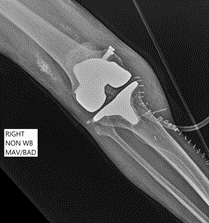
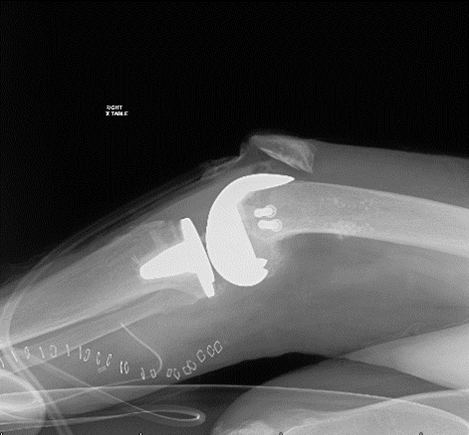
At that point, a discussion regarding above knee amputation vs. limb salvage ensued with the patient and his family. At baseline, he was a community ambulator without assistive devices. Given his age and the lower likelihood of being able to ambulate with a prosthesis in the setting of an above knee amputation, the patient wanted to purse any possible limb salvage option. A staged approach was discussed, with total knee resection, irrigation, debridement and complex closure, with the ultimate plan of arthrodesis to allow a stable platform for ambulation once the infection was eradicated.


The patient underwent extensive debridement of the completely necrotic patella and patellar tendon, with resection of his TKA components and medial epicondyle screws. The distal femoral and proximal tibial surfaces were shortened and narrowed to allow soft tissue and wound closure. The femoral and tibial canals were debrided and reamed, and antibiotic polymethylmethacrylate cement dowels were placed impregnated with vancomycin, tobramycin, amphotericin B and voriconazole. The femoral and tibial surfaces were apposed and held with crossed Steinmann pins for provisional stability (Figure 4). The quadriceps mechanism was mobilized and pie crusted to advance it as far distally as possible to facilitate soft tissue closure (Figure 5). The extremity was placed in a long-leg cast in extension to protect the wound. Intraoperative cultures were positive for Candida parapsilosis. He was placed on 6 weeks of appropriate IV antibiotics and an oral antifungal agent to cover the organisms cultured. The wound will be monitored closely and a surgical determination will be made depending on whether the wound ultimately heals.
Discussion
The vascular supply to the skin overlaying the anterior knee is primarily derived from the medial genicular arteries, with an anastomosis that exists just superficial to the deep fascia. When planning a conversion or revision TKA with multiple previous incisions, it is recommended to utilize the most lateral incision and create a full-thickness subfascial flap to preserve the more superficial anastomosis of vessels. Large subfascial medially based flaps through a laterally based incision can be safely raised, minimizing wound complications. With proper technique, staying completely subfascial with dissection, the blood supply to the skin is preserved allowing appropriate wound perfusion and healing. Whenever two incisions exist, the most lateral incision should be used regardless of the distance between the existing lateral incision and an existing medial incision or a planned midline incision (Figure 6). The concept of a safe numerical distance between incisions is unsafe and should be abandoned. Patient risk factors for wound necrosis include rheumatoid arthritis, diabetes mellitus, obesity, smoking and malnutrition. However, the patient in this case did not have any of these risk factors. The catastrophic ischemic wound necrosis and dehiscence likely resulted due to the violated blood supply to the midline incision skin edges, due to the close proximity to the long curvilinear lateral incision that was utilized previously.

Wound necrosis and persistent drainage in the early postoperative period requires prompt attention and surgical management to mitigate the risk of a deep wound or prosthetic joint infection. In this case, the patient underwent prompt irrigation and debridement, however, due to the skin necrosis, a soft tissue defect resulted, which ultimately required a medial gastrocnemius rotational flap and split-thickness skin graft for coverage 1 week later.

The gastrocnemius rotational flap provides reliable coverage in the setting of an exposed, infected prosthesis. However, TKA resection should be performed at the time of flap coverage, as opposed to flap coverage of an implant destined for chronic prosthetic joint infection.

Unfortunately, in this case, the wound progressed to full-thickness necrosis, with flap breakdown, leading to an ultimately exposed and necrotic extensor mechanism. The patient was referred to our center at this point and had the limited options of limb salvage with an ultimate goal of fusion vs. an above knee amputation. After discussion with the patient and his family, the decision was made to proceed with attempted limb salvage, which has been associated with improved clinical outcome scores and increased likelihood of return to ambulatory function. This is especially relevant given this patient’s age and decreased likelihood of managing the energy expenditure associated with prosthesis ambulation after above knee amputation.
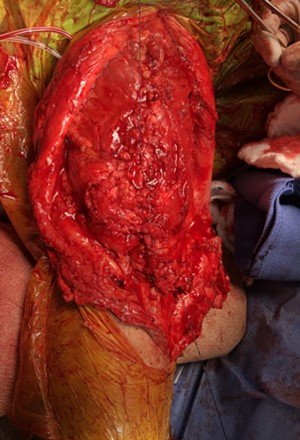
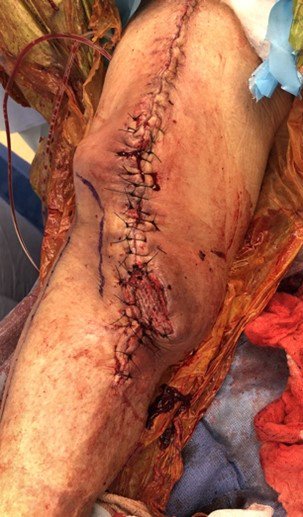
While the surgical options were limited and the prognosis is guarded, this case is presented to emphasize the prevention of this wound complication with appropriate incision choice when planning a conversion TKA.
Take-home message
In the setting of previously existing knee incisions the most lateral incision should be used for a conversion TKA. If a rotational flap is needed for soft tissue closure over an exposed implant, component resection should be performed concomitantly.
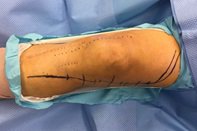

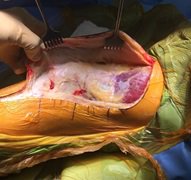
References:
Chen AF, et al. Clin Orthop Relat Res. 2012;doi:10.1007/s11999-012-2322-7.
Haertsch PA. Br J Plast Surg. 1981;doi:10.1016/0007-1226(81)90061-8.
Tetreault MW, et al. Clin Orthop Relat Res. 2016;doi:10.1007/s11999-015-4624-z.
